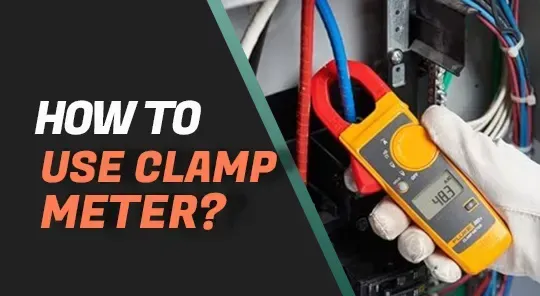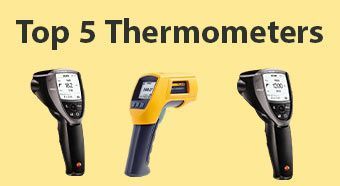What is a Multimeter?
Whether you're a Technician, electrician, an electronics hobbyist, or a DIY enthusiast, you need a multimeter in your toolbox. It's a handy device for measuring various electrical properties like voltage, current, and resistance. But over the years, multimeters have evolved beyond just the basic electrical parameters. With features like continuity checks, diode testing, and even temperature measurement, multimeters are able to adapt to many different functions and tools that can tackle a wide range of electrical diagnostics. In this guide, we’ll explore everything you need to know about multimeters in details. from what they are and how they work, to the key features you should look for when choosing the right one for your needs.
What is a Multimeter and How Does It Work?
At its most basic models, a multimeter is a tool that measures electrical values like voltage (volts), current (amperes), and resistance (ohms). But modern multimeters are far more sophisticated than the ones you may have seen years ago. Today, they are available in both digital and analog versions, and most come with a variety of additional features like continuity checks, diode testing, capacity measuring and even non-contact voltage detection (NCV).
So, how does a multimeter work? When you connect the test probes to a circuit, the device sends a small amount of current through the circuit. Based on how the circuit responds, the multimeter calculates and displays the measured value. whether it's voltage, current, or resistance. The measurements are taken through internal electronic components, such as an analog-to-digital converter (ADC) in digital models, which converts the measured signals into readable numbers.
Multimeters typically have two test leads with different colors (one red, one black) which you use to make contact with the circuit you're testing. Depending on what you're going to measure (voltage, current, or resistance) you'll either connect the leads across two points in a circuit( like when you want to check Voltage) or within the circuit itself( like the times you want to measure current). The multimeter then displays the measurement either as a digital readout or with a needle on an analog scale.
Multimeters can also measure both alternating current (AC) and direct current (DC), making them flexible tools for a wide range of applications, from household electrical work to complex industrial diagnostics.
Differences Between Digital and Analog Models.
One of the first decisions you’ll have to make when selecting a multimeter is whether to go with a digital multimeter (DMM) or an analog multimeter. Each has its own strengths, and the right choice will depend on your specific needs and experience level.
Digital Multimeters (DMMs)
Digital multimeters are by far the most common type used today. They display measurements in clear, easy-to-read numbers on an LCD screen. Because they use digital circuits, DMMs offer greater accuracy and are generally easier for beginners to use. They also often come with extra features like auto-ranging, data hold, and advanced capabilities such as measuring capacitance, frequency, and even temperature
Advantages of digital multimeters:
● Precision and Accuracy: Digital models give more precise readings than analog models, often down to decimal points.
- Auto-Ranging: Many digital multimeters have an auto-ranging feature, meaning you don’t have to manually set the range for your measurements, which simplifies the process for less experienced users and avoids damage to the device in various occasions.
- Readability: The numerical display on a DMM is easy to read, even in low-light conditions if it comes with a backlit screen.
- Additional Features: Digital multimeters frequently offer advanced functions like NCV, True RMS, diode testing, and continuity beeping.
However, digital multimeters can be more sensitive to electromagnetic interference, and some professionals argue they are less durable than their analog sisters.
Analog Multimeters
Analog multimeters feature a needle that moves across a printed scale to display the measurement. These devices can often be more durable and reliable in specific situations, particularly when dealing with fluctuating signals. Some professionals still prefer analog multimeters because they provide a real-time, visual indication of changing signals. And much better to recognize changes as they happen.
Advantages of analog multimeters:
- Detecting Fluctuations: Analog models excel at showing trends in changing electrical signals, which can be difficult to see with a digital model’s fluctuating numerical display.
- Durability: Analog meters tend to be more durable in harsh environments because they don’t rely on delicate digital components.
- No Batteries Needed (For Basic Functions): Many analog multimeters don’t require batteries to measure voltage or current, although they do need power for resistance measurements.
- Lower costs: they usually got lower prices than the digital models .
That said, analog multimeters aren’t as precise as their digital counterparts and can be more challenging to use, particularly for those new to electrical measurements. For example user can read the parameter he is measuring wrong if his pint of view is not completely vertical.
Key Features to Look for in a Multimeter
Not all multimeters are created equal, and understanding the key features that make a model more prominent, can help you choose the best one for your specific needs. Here are some of the most important factors to consider:
Auto-Ranging vs. Manual Ranging
Auto-ranging is a feature found in most modern digital multimeters that automatically selects the correct range for the measurement you’re taking. This eliminates the need to manually choose the measurement range, making the process faster and easier, especially for beginners. For example, if you're measuring voltage and you don’t know if it’s 10V or 100V, the multimeter will adjust itself automatically.
In contrast, manual-ranging multimeters require you to select the appropriate range yourself. While this gives you more control and can provide faster results in experienced hands, it’s less convenient for casual users or beginners. Some professionals prefer manual ranging for its precision and the ability to zero in on the exact range they need.
True RMS
If you’re dealing with AC circuits that don't have perfect sine waves (such as those in variable-speed motors or switching power supplies) you’ll want a multimeter with True RMS (Root Mean Square) capability. True RMS meters measure the effective value of alternating current (AC) and voltage, regardless of the waveform shape. Standard multimeters only give accurate readings for pure sine waves, while True RMS models provide accurate measurements in non-sinusoidal environments. This is critical in many modern electrical applications, where non-linear loads are common.
Data Hold
The data hold function allows you to "freeze" the current measurement on the display, which is particularly useful when you’re working in hard-to-reach places where you can’t easily see the screen. Once you’ve taken the measurement, you can pull back, view the screen, and record the value.
Backlit Display
A backlit display is an underrated but essential feature if you’re working in low-light environments, such as basements, electrical boxes, or outdoor areas at night. This feature allows you to read the display clearly without needing additional lighting.
Safety Features (CAT Ratings)
When working with high-voltage circuits, safety should be your top priority. Multimeters come with safety category ratings (CAT I, CAT II, CAT III, CAT IV), which indicate the types of environments they’re designed to handle:
- CAT I: Designed for low-energy, protected environments such as small electronics.
- CAT II:Suitable for household electrical appliances.
- CAT III: Used in higher-energy environments like electrical panels and building wiring.
- CAT IV: Designed for industrial use, such as outdoor utility work.
Ensure that the multimeter you choose has the appropriate CAT rating for the type of work you’ll be doing.
Input Protection
When working with high voltage, it's essential to have protection against accidental overloads. Many modern multimeters come with features like over-voltage protection, current-limiting fuses, and input shields that protect both the device and the user from harm.
Battery Life and Power-Saving Features
A multimeter that dies mid-measurement is frustrating. Look for models with long battery life and features like auto power-off to conserve energy when the device is idle for too long. Exploring Additional Features: Diode Testing, Continuity Checks, Temperature Measurements, NCV, and True RMS
While measuring voltage, current, and resistance are the core functions of any multimeter, many advanced models offer additional features that make them more versatile tools. Here are some of the most useful extras to look for:
Diode Testing
Diodes are components that allow electrical current to flow in only one direction. In circuits, diodes are essential for preventing reverse currents that can damage components. With a multimeter's diode testing function, you can quickly check if a diode is functioning properly by measuring its forward voltage drop. If the diode is faulty, the multimeter will show either an open circuit or no voltage drop, signaling the need for replacement.
Continuity Checks
One of the simplest but most useful features in any multimeter is the continuity test. This feature helps you determine if a circuit is complete, meaning electricity can flow without interruption. A typical continuity check involves the multimeter beeping when it detects a closed loop, allowing you to easily identify broken connections or faulty wiring.
Temperature Measurements
If you’re working with HVAC systems, electronics with heat-sensitive components, or any environment where temperature monitoring is critical, some multimeters come with thermocouples or infrared sensors for measuring temperature. This feature makes the multimeter an all-in-one tool for both electrical and temperature diagnostics.
Non-Contact Voltage (NCV)
Non-contact voltage detection (NCV) is a lifesaver when it comes to working in high-voltage environments. With this feature, you don’t need to make direct contact with a wire to determine if it’s live. Instead, the multimeter can sense the presence of voltage through insulation or even air, reducing the risk of electric shock. This is especially useful for quick safety checks before working on a circuit.
True RMS for Accurate AC Measurements
As discussed earlier, True RMS capability is vital for accurate measurements of AC circuits with non-sinusoidal waveforms. This feature ensures your multimeter can handle complex waveforms, which are common in many modern electrical systems.






